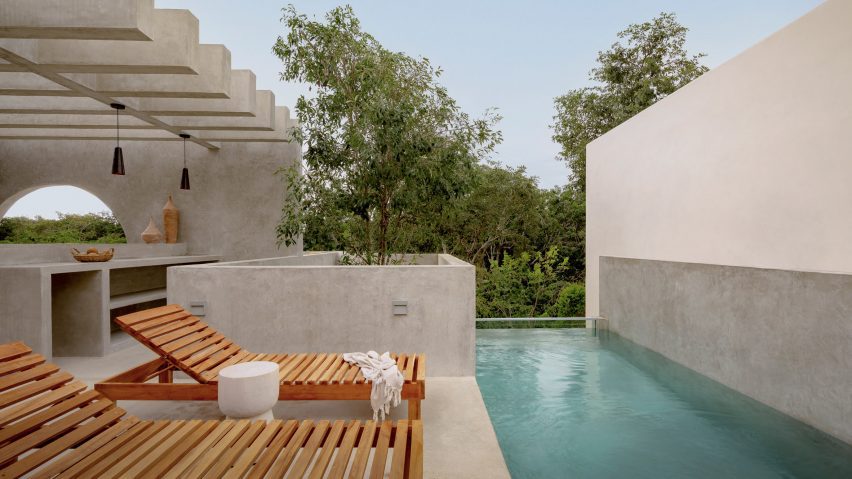Mexican practice Espacio 18 Arquitectura has designed a concrete holiday home in Tulum with a circular window in one of the ceilings that reveals a swimming pool.
Villa Cava is a fortress-like house that takes cues from brutalism and is surrounded by lush vegetation in Tulum's Aldea Zamá neighbourhood.
Clad in board-formed concrete, the home is split between two levels and also features a rooftop garden.
Espacio 18 was informed by cenotes when designing the house – ancient sunken water-filled limestone pits and caves found in Mexico's Yucatán Peninsula.
"The concrete was the result of a search to maintain a timeless architecture without maintenance that would adapt to the humid environment of Tulum, as well as hurricanes," explained architects Carla Osorio and Mario Ávila.
Described as a "habitable sculpture", visitors enter Villa Cava through a geometric double-height entrance that was constructed around two existing trees and leads to a staircase.
This hallway is illuminated by a striking circular window in the ceiling that reveals a rooftop swimming pool from below. Blue-hued light filters through the opening and reinforces the cavernous atmosphere.
"It represents a cenote, and there is something amazing about the reflections on the walls that the water creates," Osorio and Ávila told Dezeen.
An open-plan kitchen, a study and an airy living space feature on the first floor, which also includes another swim-up pool.
Private bedrooms and bathrooms are contained on the second level where nine-metre-tall ceilings and a selection of skylights cast an abundance of natural light on the interiors.
Throughout these spaces, interior designer Kayla Pongrac opted for light timber accents and neutrally toned furniture while smooth concrete floors and walls echo the home's facade.
The rooftop provides additional outdoor seating and presents views of the surrounding trees.
Chunky, zigzagged concrete shapes that contain internal staircases protrude from various areas of the facade, enhancing its striking outward appearance.
Espacio 18 designed the villa in collaboration with a young couple from Canada who were drawn to Mexico.
"The inspiration came from the magical Cenote Suytun in Yucatán, which captured [the couple's] hearts, and they decided to create a home that embodied the natural beauty and spatial quality of the region," said Osorio and Ávila.
Based in Oaxaca, Espacio 18 previously designed a townhouse with an internal courtyard in Puebla and a seafront Oaxacan home with two wings oriented to follow the rising and setting of the sun.
The photography is by César Béjar.

